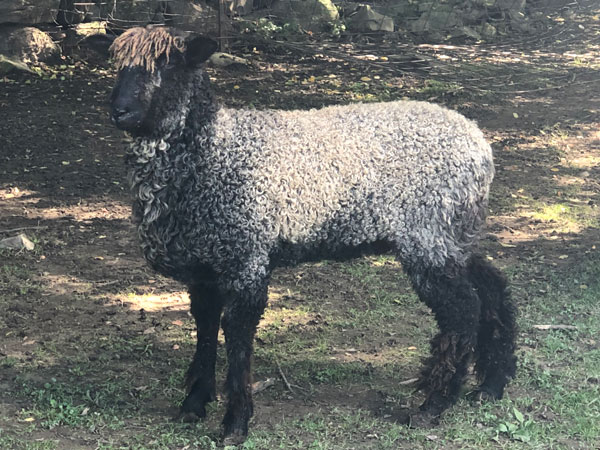
The Black Cotswold Society was founded in 1990 with the help and support of the American Cotswold Record Association. The mission was to develop and register a breed of sheep from the offspring of the Cotswold sheep that can not be registered with ACRA due to the expression of color. In every other way besides color, these Cotswolds are the same. Over the years, this registry existed but was neither formally tied to ACRA through bylaws nor did this society have oversight from a board. In 2023, ACRA updated its bylaws to formalize the Black Cotswold Registry with oversight, structure and a commitment to grow and protect these Cotswold sheep.
The genetics of color in a typical European based white longwool sheep are very interesting. The book, “Practical Color Genetics for Livestock Breeders“ by Dr. Phillip Sponenberg takes an in depth look at color genetics in a sheep. It is a great read for shepherds who want to raise black Cotswold sheep and goes into detail about the genetics of color. Another good reference can be found at Genetics of Coloured Sheep.
Over the centuries, the wool trade needed and would only purchase all white wool leading those raising sheep for wool to breed out those animals who lambed or sired color. This created sheep expressing all white wool with no black areas. Cotswolds, however, retained their dark hooves and nose with their white long locks. Dr. Sponenberg writes, “The white fleeces of most of the European breeds of world sheep have been achieved by selecting for completely pheomelanic pigmentation, and then subsequently diluting the pheomelanin to pale cream or white. Most white wool is the end result of this somewhat complicated cascade of events. Breeders selecting for colored wool…have to work in the opposite direction against millennia of selection…a difficult task.” That said, a black offspring from two ACRA registered sheep can happen.
Color expression can occur in multiple genetic ways in a sheep and much depends upon where the fiber is located on the animal. The short fibers on the face of a Cotswold may have color associated with them which we see with spots on the face and ears of a white Cotswold sheep as well as darker areas around the nose and tongue area. This coloring is allowed for ACRA registration and is part of the breed standard. Cotswold sheep have been claimed to have one of the whitest of white fleeces and this is due to the years of selection as well as what is called white spotting. Some white spotting helps the fleece, excessive white spotting will lead to white on hooves and the nose area and this extra spotting can be a very recognizable issue when breeding for all black sheep.
There are many genetic factors that must line up to obtain an all black Cotswold sheep. During this process, the genetic patterns hidden because of the layers of white on white can be revealed! Detailed record keeping and great pictures are encouraged to help all of those interested in Cotswold genetics and progress the breed.
The Black Cotswold breed provides much to the sheep industry from beautiful fleeces for the hand spinner and fiber artist to fantastic lamb and mutton. They are the rarest of the rare and a great addition to any pasture!
ACRA’s bylaws allow for registration of all Cotswold sheep. By keeping all white and natural (Black or have an expression of color) Cotswold sheep registries separate, we keep the heritage of the white Cotswold inline with the almost 150 year breed standard as well as the UK’s breed standard but also welcome those Cotswolds that meet the Black Cotswold Registry (BCR) breed standard.
